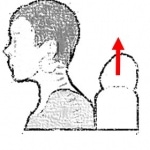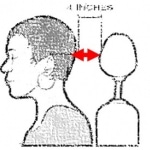Three Things You Can Do to Save Yourself a Lifetime Of Neck Pain!
Neck injuries in car crashes are a big issue. In fact, such a big deal that major car makers have been designing seats for years to reduce the risk of serious neck injury. What used to be called “whiplash” with a roll of the eye, is now known to be host of serious injuries such as those to the joints and discs in the neck. Many patients who get these injuries in rear end crashes are never quite the same (although we have a great track record of helping many). So what can you do right now to reduce the risk of a huge neck injury? Is it possible to prevent whiplash?
1. Check your seat and head restraint. Most of us don’t think about how we fit into our car seats. However, in a rear end crash, the distance between your head and the “head rest” is one of the things that could make the difference between walking away without injury and a lifetime of neck pain.
A. Adjust the height! If you’re tall or even just average height, your head restraint may be too low. Adjust it so that the middle of the back of your head meets the middle of the head rest. A head restraint that’s too low will allow the head to pivot over the restraint, causing serious injury to the structures in the front of your neck.

2. There is a huge difference in how different cars protect their occupants in a rear end crash. I bet you didn’t know that for almost a decade the Insurance Institute for Highway Safety has been testing the performance of various cars in protecting the neck in a read end crash. You can check your car seat right now on their ratings site. Just enter your make, model, and year and the various ratings will pop up. Just click on “Head Restraints and Seats” to get more details. As an example, a 2010 Chrysler PT Cruiser has poor neck protection ratings, while a 2014 Acura MDX gets great ratings.
If your car gets a bad rating, you may not be able to change your car right now, but if you have more than one family car and you have a history of neck issues, why not take the one that has a better neck protection rating? If you can’t use another car, consider getting a simple device that can close the gap between your neck and the seat.
3. The small stuff you can do… First, wear your seat belt as it will position you in the seat in a crash. Don’t tailgate, as someone that stops short in front means that you’re more likely to get rear ended. Sit upright! Meaning that slouching forward while you drive will increase the distance between the back of your head and the seat. If you do hear brakes screeching behind you and have time to react, push your head against the head restraint!
The upshot? Take a few minutes to make yourself more bomb proof against neck injuries! While many people will get an annual check up, few take the time to go out and do simple things like check their head rest. Do it now!

If you have questions or comments about this blog post, please email us at [email protected]
NOTE: This blog post provides general information to help the reader better understand regenerative medicine, musculoskeletal health, and related subjects. All content provided in this blog, website, or any linked materials, including text, graphics, images, patient profiles, outcomes, and information, are not intended and should not be considered or used as a substitute for medical advice, diagnosis, or treatment. Please always consult with a professional and certified healthcare provider to discuss if a treatment is right for you.

